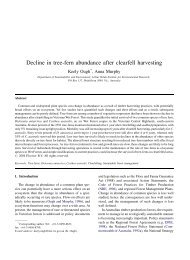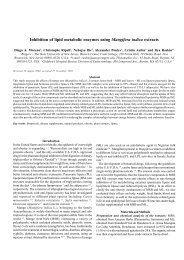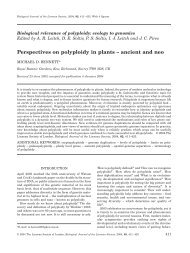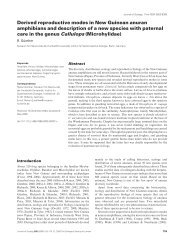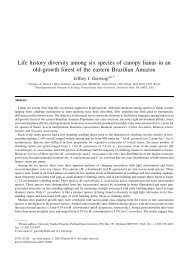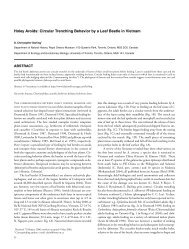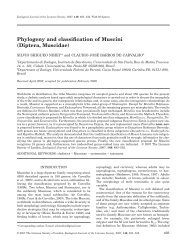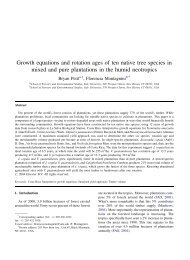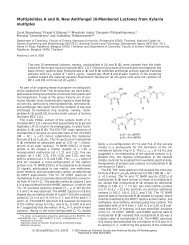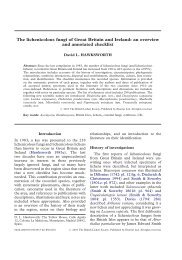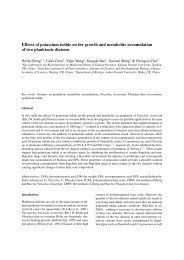Frequency of Cyanogenesis in Tropical Rainforests of Far North ...
Frequency of Cyanogenesis in Tropical Rainforests of Far North ...
Frequency of Cyanogenesis in Tropical Rainforests of Far North ...
Create successful ePaper yourself
Turn your PDF publications into a flip-book with our unique Google optimized e-Paper software.
which may occur beyond 24 h (Saupe et al., 1982). Tissue <strong>of</strong><br />
known cyanogenic species, Prunus turneriana or Ryparosa<br />
javanica, was used as a positive control. Moderate to<br />
strongly cyanogenic samples gave a positive result with<strong>in</strong><br />
a few m<strong>in</strong>utes or up to a few hours, while more weakly<br />
cyanogenic samples took several more hours. In accordance<br />
with the recommendations <strong>of</strong> Br<strong>in</strong>ker and Seigler (1989), a<br />
new test was conducted for any samples produc<strong>in</strong>g a slow<br />
positive response (24 h) <strong>in</strong> case <strong>of</strong> <strong>in</strong>terference by microbial<br />
cyanogenesis. In addition, any samples with <strong>in</strong>conclusive<br />
colour change were re-tested. An <strong>in</strong>dividual was considered<br />
cyanogenic if a positive, repeatable result was obta<strong>in</strong>ed,<br />
and a species was considered cyanogenic if at least<br />
one <strong>in</strong>dividual produced a consistent and repeatable<br />
positive result. A negative test result <strong>in</strong>dicates the absence<br />
<strong>of</strong> a cyanogenic glycoside, or <strong>of</strong> the specific cyanogenic<br />
b-glycosidase, or both.<br />
In the few <strong>in</strong>stances where <strong>in</strong>sufficient tissue was available<br />
for both FA paper tests us<strong>in</strong>g fresh leaves and subsequent<br />
laboratory analysis, cyanogenesis was determ<strong>in</strong>ed<br />
based on the quantitative assay <strong>of</strong> freeze-dried ground<br />
leaf tissue (as described below) by comparison with a<br />
negative tissue control (e.g. Alstonia scholaris or Aglaia<br />
meridionalis).<br />
In this study, tests for cyanogenesis used approx.<br />
1–2 g f. wt <strong>of</strong> leaves, which is larger than tissue samples<br />
tested <strong>in</strong> previous surveys (e.g. 50 mg f. wt by Lewis and<br />
Zona, 2000; and 200 mg f. wt by Thomsen and Brimer,<br />
1997; Buhrmester et al., 2000). Accord<strong>in</strong>g to Dickenmann<br />
(1982) who used 500 mg f. wt tissue, a weak positive reaction<br />
with FA papers, where part <strong>of</strong> the paper turns blue,<br />
<strong>in</strong>dicated approx. 2–20 mg HCN kg –1 f. wt, while a strong<br />
reaction <strong>in</strong>dicated >50 mg HCN kg –1 f. wt. These lower<br />
values equate to just over 6–60 mg HCN g –1 d. wt us<strong>in</strong>g a<br />
conversion based on the mean foliar water content <strong>of</strong><br />
several species <strong>in</strong> this study, which was 70 %. In this<br />
study, based on fresh leaf tests and quantitative analysis<br />
<strong>of</strong> freeze-dried tissue from the same sample, the threshold<br />
sensitivity <strong>of</strong> FA papers was similar, with<strong>in</strong> the range<br />
5–8 mg HCN g –1 d. wt. This threshold sensitivity <strong>of</strong> FA<br />
papers corresponds well to the criteria <strong>of</strong> Adsersen<br />
et al. (1988) for classify<strong>in</strong>g <strong>in</strong>dividuals as cyanogenic,<br />
where <strong>in</strong>dividuals with



